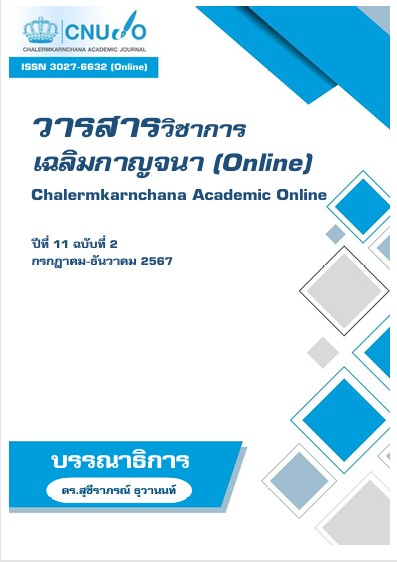ปัจจัยที่มีผลต่อการเลือกศึกษาต่อระดับปริญญาตรีของนักเรียนมัธยมศึกษาตอนปลาย ในประเทศไทย
คำสำคัญ:
การศึกษาต่อ, ปัจจัยที่มีผล, นักเรียนมัธยมศึกษาตอนปลาย, อุดมศึกษา, นโยบายการศึกษาบทคัดย่อ
การศึกษานี้มีวัตถุประสงค์เพื่อวิเคราะห์ปัจจัยที่มีผลต่อการเลือกศึกษาต่อระดับปริญญาตรีของนักเรียนมัธยมศึกษาตอนปลายในประเทศไทย โดยมุ่งเน้นศึกษาปัจจัย 5 ด้าน ได้แก่ ปัจจัยส่วนบุคคล ปัจจัยทางครอบครัว ปัจจัยทางเศรษฐกิจ ปัจจัยด้านสถาบันการศึกษา และนโยบายของรัฐ การวิจัยนี้ใช้ระเบียบวิธีแบบผสม (Mixed-Methods Research) ประกอบด้วยการเก็บข้อมูลเชิงปริมาณโดยใช้แบบสอบถามจากกลุ่มตัวอย่างจำนวน 384 คน และการสัมภาษณ์เชิงลึกกับผู้ที่เกี่ยวข้อง
ผลการวิจัยพบว่า ปัจจัยด้านสถาบันการศึกษาและปัจจัยส่วนบุคคลมีผลต่อการตัดสินใจศึกษาต่อสูงที่สุด โดยเฉพาะ คุณภาพหลักสูตร (ค่าเฉลี่ย 4.35) และความสนใจในสาขาวิชา (ค่าเฉลี่ย 4.32) รองลงมาคือ การสนับสนุนจากผู้ปกครอง (ค่าเฉลี่ย 4.45) ซึ่งเป็นปัจจัยสำคัญในกลุ่มปัจจัยทางครอบครัว นอกจากนี้ โอกาสได้รับทุนการศึกษา (ค่าเฉลี่ย 4.02) มีผลมากกว่าค่าใช้จ่ายโดยรวม ในขณะที่ นโยบายของรัฐ (ค่าเฉลี่ย 3.97) มีอิทธิพลในระดับปานกลาง
ข้อเสนอแนะจากการวิจัยนี้ ได้แก่ (1) มหาวิทยาลัยควรพัฒนาคุณภาพหลักสูตรให้สอดคล้องกับตลาดแรงงานและเพิ่มระบบแนะแนวอาชีพ, (2) ครอบครัวควรมีบทบาทสนับสนุนการศึกษาของบุตรหลานมากขึ้น, (3) ภาครัฐควรปรับปรุงระบบทุนการศึกษาให้เข้าถึงง่ายขึ้น และพัฒนากลไกสนับสนุนทางการเงินที่ยืดหยุ่นสำหรับนักเรียนที่ต้องการศึกษาต่อ งานวิจัยนี้สามารถใช้เป็นแนวทางในการพัฒนา นโยบายการศึกษาและกลยุทธ์ส่งเสริมการศึกษาต่อในระดับปริญญาตรีของประเทศไทย
References
Becker, G. S. (1993). Human capital: A theoretical and empirical analysis, with special
reference to education (3rd ed.). The University of Chicago Press.
Bourdieu, P. (1986). The forms of capital. In J. Richardson (Ed.), Handbook of Theory and
Research for the Sociology of Education (pp. 241–258). Greenwood.
Cabrera, A. F., & La Nasa, S. M. (2000). Understanding the college choice process. New
Directions for Institutional Research, 2000(107), 5-22.
Chapman, D. W. (1981). A model of student college choice. The Journal of Higher
Education, 52(5), 490-505.
Choy, S. P. (2001). Students whose parents did not go to college: Postsecondary access,
persistence, and attainment. National Center for Education Statistics, U.S. Department
of Education.
Eccles, J. S., Barber, B. L., Stone, M., & Hunt, J. (2004). Extracurricular activities and
adolescent development. Journal of Social Issues, 59(4), 865-889.
Hossler, D., & Gallagher, K. S. (1987). Studying student college choice: A three-phase model
and the implications for policymakers. College and University, 62(3), 207-221.
Hossler, D., Schmit, J., & Vesper, N. (1999). Going to college: How social, economic, and
educational factors influence the decisions students make. Johns Hopkins University
Press.
Kotler, P., & Fox, K. F. A. (1995). Strategic marketing for educational institutions (2nd ed.).
Prentice Hall.
Maslow, A. H. (1943). A theory of human motivation. Psychological Review, 50(4), 370-396.
McDonough, P. M. (1997). Choosing colleges: How social class and schools structure
opportunity. State University of New York Press.
OECD. (2018). Education at a glance 2018: OECD indicators. Organisation for Economic Co-
operation and Development.
Pascarella, E. T., & Terenzini, P. T. (2005). How college affects students: A third decade of
research (Vol. 2). Jossey-Bass.
Paulsen, M. B., & St. John, E. P. (2002). Social class and college costs: Examining the
financial nexus between college choice and persistence. The Journal of Higher
Education, 73(2), 189-236.
Perna, L. W. (2006). Studying college choice: A proposed conceptual model. Higher
Education: Handbook of Theory and Research, 21, 99-157.
Thailand Ministry of Education. (2021). Higher education development policy and financial
support programs.
UNESCO. (2020). Education in the COVID-19 era: Opportunities and challenges. United
Nations Educational, Scientific and Cultural Organization.
กระทรวงศึกษาธิการ. (2564). รายงานสถิติการศึกษาของประเทศไทย ประจำปี 2564. สำนักนโยบาย
และยุทธศาสตร์.
สำนักงานคณะกรรมการการอุดมศึกษา. (2564). แนวทางการพัฒนาการศึกษาและทุนการศึกษาสำหรับ
นักเรียนมัธยมศึกษาตอนปลาย.
สำนักงานสถิติแห่งชาติ. (2565). รายงานภาวะการศึกษาไทย: การศึกษาต่อของนักเรียนมัธยมศึกษาตอน
ปลาย.
เผยแพร่แล้ว
How to Cite
ฉบับ
บท
License
Copyright (c) 2025 วารสารวิชาการเฉลิมกาญจนา (Online)

This work is licensed under a Creative Commons Attribution-NonCommercial-NoDerivatives 4.0 International License.





